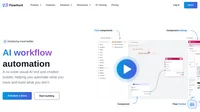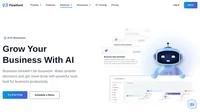An AI Automation System is an advanced integration of artificial intelligence (AI) technologies with automation processes designed to enhance the capabilities of traditional automation. This system marries AI’s cognitive abilities—such as learning, reasoning, and problem-solving—with the efficiency and consistency of automated processes, enabling the performance of complex tasks with minimal human intervention. AI automation systems are engineered to manage a variety of operations, from data analysis, decision-making, and workflow management to customer service interactions. As industries continue to evolve, AI Automation Systems stand at the forefront of digital transformation, promising increased efficiency and innovation.
Recent advancements in AI and automation are transforming how businesses operate. The current trends in 2024 emphasize the convergence of AI and automation technologies to drive productivity and innovation. According to recent insights, organizations are increasingly adopting intelligent document processing (IDP) to streamline document management workflows, enhancing efficiency and reducing manual efforts. Transparency in AI operations is gaining traction, enabling organizations to maintain trust and accountability by providing comprehensive insights into AI-driven processes. Virtual Desktop Assistants, or “Copilots,” are revolutionizing workplace productivity by automating routine tasks and offering personalized support. Moreover, advancements in Generative AI and Natural Language Processing (NLP) are paving the way for more human-like interactions and creative automation solutions.
Components of AI Automation Systems
- Artificial Intelligence (AI): AI encompasses technologies that enable machines to mimic human cognitive functions such as learning and problem-solving. It includes machine learning (ML), natural language processing (NLP), computer vision, among others. AI provides the decision-making capability within automation systems, allowing for more intelligent and adaptable operations.
- Machine Learning (ML): A subset of AI focused on enabling systems to learn from data and improve their performance over time without explicit programming. ML is vital for predictive analytics and pattern recognition in AI automation, allowing systems to adapt to new data and conditions.
- Robotic Process Automation (RPA): Focused on automating rule-based, repetitive tasks that do not require decision-making. RPA is often integrated with AI to form intelligent automation, which can handle more complex and dynamic processes, improving operational efficiency and accuracy.
- Business Process Management (BPM): Involves the automation and optimization of business processes to enhance workflow efficiency. BPM ensures that AI automation systems can seamlessly integrate various processes and systems, driving organizational agility and effectiveness.
- Natural Language Processing (NLP): A branch of AI that helps machines understand, interpret, and respond to human language. NLP is instrumental in developing chatbots and virtual assistants, enhancing customer service by providing accurate and timely responses.
Use Cases of AI Automation Systems
- Customer Service: AI-powered chatbots and virtual assistants automate responses to customer inquiries, reducing wait times and freeing human agents to address more complex issues, thereby enhancing customer satisfaction and operational efficiency.
- Financial Services: AI systems automate tasks like loan processing, fraud detection, and compliance management by quickly and accurately analyzing vast amounts of financial data, leading to improved decision-making and risk management.
- Healthcare: Automation systems assist in patient data management, appointment scheduling, and diagnostics through AI analysis of medical images and records, improving healthcare delivery and patient outcomes.
- Manufacturing: AI automation in manufacturing can predict equipment failures, optimize supply chains, and enhance product quality through data-driven insights, leading to increased productivity and reduced operational costs.
- Insurance: Automates claims processing, policy management, and customer service, offering quick and accurate service while maintaining compliance, which enhances customer satisfaction and operational efficiency.
Benefits of AI Automation Systems
- Increased Efficiency and Productivity: By automating repetitive tasks, AI systems allow human workers to focus on strategic and creative activities, enhancing overall productivity.
- Cost Reduction: Automation reduces the need for manual labor and minimizes errors, leading to significant cost savings in operations.
- Enhanced Decision-Making: AI systems provide data-driven insights and predictions, enabling businesses to make informed and accurate decisions.
- Scalability: AI automation systems can easily adapt to increased workloads and changing demands without compromising efficiency or quality.
- Improved Customer Experience: AI provides personalized and timely interactions, improving customer satisfaction and loyalty.
Challenges of AI Automation Systems
- Data Quality and Availability: AI systems require high-quality and relevant data for accurate decision-making. Data silos and privacy concerns can limit data accessibility.
- Ethical Considerations: Concerns about data privacy, bias, and transparency in AI decision-making require careful management to build trust and ensure compliance.
- Integration Complexity: Ensuring seamless integration with existing legacy systems and workflows can be challenging and requires skilled professionals.
- Skill and Talent Gap: The demand for professionals with expertise in AI and automation technologies exceeds supply, hindering implementation.
- Change Management: Organizations must manage employee resistance to AI adoption through training and communication to ensure smooth transitions.
Future of AI Automation Systems
AI automation systems are poised to evolve with advancements in generative AI, which will introduce creativity and adaptability to automation processes. The collaboration between humans and machines, known as augmented intelligence, will enhance the potential of automation systems, driving further innovation and efficiency across industries. As AI technologies advance, businesses will increasingly rely on AI automation systems to maintain competitive advantages and meet customer demands.



